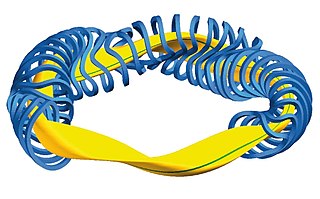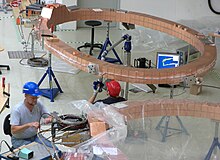
Back مفاعل فيندلشتاين 7 إكس Arabic Wendelstein 7-X BS Wendelstein 7-X Catalan Wendelstein 7-X Czech Wendelstein 7-X Danish Wendelstein 7-X German Wendelstein 7-X Greek Wendelstein 7-X Spanish Wendelstein 7-X Finnish Wendelstein 7-X French
 W7-X in 2011 | |
| Device type | Stellarator |
|---|---|
| Location | Greifswald, Germany |
| Affiliation | Max Planck Institute for Plasma Physics |
| Technical specifications | |
| Major radius | 5.5 m (18 ft) |
| Minor radius | 0.53 m (1 ft 9 in) |
| Plasma volume | 30 m3 |
| Magnetic field | 3 T (30,000 G) |
| Heating power | 14 MW |
| Plasma temperature | (6–13)×107 K |
| History | |
| Year(s) of operation | 2015–present |
| Preceded by | Wendelstein 7-AS |
| Links | |
| Website | https://www.ipp.mpg.de/w7x |





The Wendelstein 7-X (abbreviated W7-X) reactor is an experimental stellarator built in Greifswald, Germany, by the Max Planck Institute for Plasma Physics (IPP), and completed in October 2015.[1][2] Its purpose is to advance stellarator technology: though this experimental reactor will not produce electricity, it is used to evaluate the main components of a future fusion power plant; it was developed based on the predecessor Wendelstein 7-AS experimental reactor.
As of 2023[update], the Wendelstein 7-X reactor is the world's largest stellarator device.[3] After two successful operation phases ending in October 2018, the reactor was taken offline for upgrades.[4][5] The upgrade completed in 2022. New fusion experiments in February 2023 demonstrated longer confinement and increased power.[6] The goal of this phase is to gradually increase power and duration for up to 30 minutes of continuous plasma discharge, thus demonstrating an essential feature of a future fusion power plant: continuous operation.[7][8]
The name of the project, referring to the mountain Wendelstein in Bavaria, was decided at the end of the 1950s, referencing the preceding project from Princeton University under the name Project Matterhorn.[9]
The research facility is an independent partner project of the Max-Planck Institute for Plasma Physics with the University of Greifswald.
- ^ Introduction – the Wendelstein 7-X stellarator Retrieved 5 November 2014.
- ^ Clery, Daniel (21 October 2015). "The bizarre reactor that might save nuclear fusion". sciencemag.org. Science Magazine. Retrieved 25 October 2015.
- ^ "Wendelstein 7-X achieves world record". Max Planck Institute for Plasma Physics. Retrieved 27 December 2022.
- ^ "The second experimentation phase". Max Planck Institute for Plasma Physics. Retrieved 26 September 2022.
- ^ Milch, Isabella. "Wendelstein 7-X fusion device at Greifswald to be upgraded". Max Planck Institute for Plasma Physics. Retrieved 26 September 2022.
- ^ "Wendelstein 7-X reaches milestone: Power plasma with gigajoule energy turnover generated for eight minutes". 22 February 2023.
- ^ idw-online.de: Federal Research Minister Stark-Watzinger and Minister Martin visit IPP Greifswald, backup: Citat: "...After two successful initial operation phases, the Wendelstein 7-X fusion device has been further expanded. This final step, which upgrades the machine to demonstrate plasma pulses of up to 30 minutes with increased heating power, has now been completed and Wendelstein 7-X is finished. A water-cooled inner cladding and the new centrepiece, a water-cooled divertor, complete the device. In autumn 2022, Wendelstein 7-X will go back into operation..."
- ^ ipp.mpg.de: Wendelstein 7-X on the verge of new peak performance: Citat: "...From autumn 2022 onwards, an international team of scientists will once again drive W7-X to new heights of performance. "With the improved equipment, we want to be able to keep high-performance plasmas with up to 18 gigajoules of energy turnover stable for half an hour in a few years," [...] approaching this goal step-by-step and learning more about plasma operation at higher energies without putting too much stress on the machine too quickly,[...]"
- ^ WI-A, WI-B, WII-A, WII-B, W7-A: G. Grieger; H. Renner; H. Wobig (1985), "Wendelstein stellarators", Nuclear Fusion (in German), vol. 25, no. 9, p. 1231, doi:10.1088/0029-5515/25/9/040, S2CID 250832456
© MMXXIII Rich X Search. We shall prevail. All rights reserved. Rich X Search